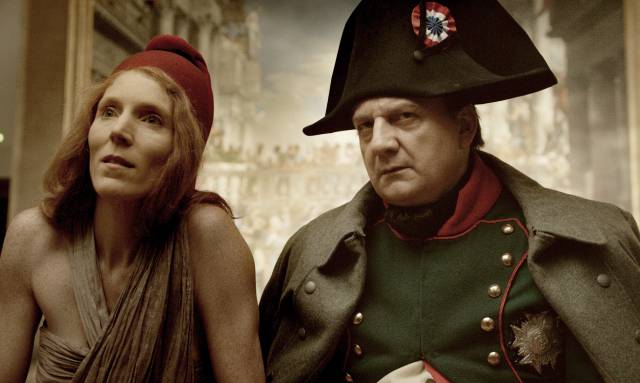

In several ways, Francofonia announces itself as a companion to director Aleksandr Sokurov’s 2002 breakout feature, Russian Ark. The earlier film used the massive Hermitage museum in St. Petersburg as a setting for a fantasia of Russian history and art in a record-holding single take. Francofonia also concerns itself with a super-sized museum —the Louvre in Paris — but this time, Sokurov is more measured and critical in his approach.
In the opening scene, the director, playing some version of himself, communicates with a captain of a ship hauling artworks across a stormy sea. Although the film’s form, genre, and structure frustrate any easy categorization, at least this scene sets out the bulk of the thematic content clearly. The captain is struggling with the seas, unwilling to shed the heavy load of artwork. It is a scene about the movement of artifacts — the effort behind their placement in various museums. Casual museumgoers tend to forget the logistics behind a piece’s presence before them, and the logistics that are necessary for these works to gain their powerful position on the artistic pantheon. This film is not willing to ingest the museum experience ignorant of this. But the captain’s attitude is the second important part of this opening. He senses the potential tragedy of dying in an effort to preserve the artwork, recognizes the absurdity of that fate, but most of all fears that it will indeed be lost. After all, Sokurov and his film never deny the profound, timeless value of great art. For Sokurov, art’s interplay with power is all the more troubling because of its inherent virtue.
As the movie moves forward, several different sequences begin to unfold. Real historical footage, then mock-historical footage, some figures (I won’t spoil who) flitting through the Louvre. The director’s study is revisited, as is the captain. The director narrates at times, then at others, fictionalized accounts of history take over. It’s a bit like Virginia Woolf’s A Room of One’s Own: a sprawling, digressive essay with occasional historic-fictional flourishes.
Most interesting is the way Sokurov examines Nazism and art, especially in the context of the typical treatment of this subject. Frequently, the conquering Germans are cast as the teeth-gnashing enemies of art, destroying the culture of all those they conquer. Sokurov problematizes this easy, Hollywood-friendly narrative first by telling the story of the Louvre’s salvation during the Nazi occupation of Paris and also, more importantly, by gesturing toward the violence inherent in art’s elevated cultural station. Although “great art” is taken for granted, as though it is preserved by its brilliance alone, its consolidation and preservation is in fact the product of institutional power and, at times, brute force. Pitting conquering hordes versus innocent, beautiful art is misleading. One must recognize that art was built on that same power and violence in the first place.
Sokurov focuses on the notion of legacy in general. His attention to its construction and fickleness make Francofonia a much richer, and yet more halting and lumbering film than Russian Ark. There, history was a grand spectacle, for the awe-struck consumption of the viewer. Here, the many tones and perspectives make the viewer struggle. But then again, maybe in its difficulty, Sokurov has succeeded in turning the film itself into a stronger entry to the artistic pantheon.